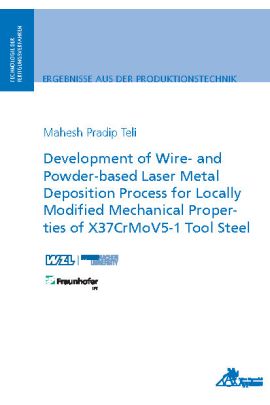X37CrMoV5-1 or H11 is the most important hot-work tool steel material in all types of hot-working processes because of its high strength level, wear resistance, toughness, good resistance to thermal fatigue cracking (heat checking), and excellent resistance to gross cracking and thermal shock. Nonetheless, there are many ways in which a H11-made forging die can be damaged due to a number of failure mechanisms; for instance, wear, plastic deformation, gross cracking, thermal fatigue, and mechanical fatigue. Among these failure mechanisms, wear and heat checking are the most dominant failure mechanisms accounting ~70% of total failures in all hot forging operations followed.
Therefore, the present work was aimed to reduce the severity of wear and heat checking by locally improving and controlling the hardness and the grain size refinement of Nb alloyed H11 tool steel on existing H11 dies. It was realized through the development in wire- and powder-based laser metal deposition process and alloy composition design. The WP-LMD process is a beyond state-of-the-art process, which was realized in the present thesis by simultaneously depositing wire (H11) and powder (Nb) materials. Niobium (Nb) has potential to refine the microstructure of tool steel materials through the precipitation of niobium carbides (NbC); hence, niobium was selected as a special alloy element to modify and control hardness and grain size refinement of H11 tool steel.
The purposes of the present work were fourfold:
• It was intended to modify H11 tool steel grade via the chemical composition design and high solidification method, with a better representation of the shape of the microstructures, for local enhancement in hardness and grain size refinement.
• The work was extended to improve on the production technology i.e. Laser Metal Deposition (LMD) by adapting both powder and wire deposition strategies simultaneously.
• The third aspect of the work was to clarify the relationship between mechanical properties and microstructure of Nb alloyed H11 tool steel. A number of microstructure characteristics were considered in the present thesis, viz., average grain size, average carbide size and distribution, chemical composition, and volume fraction.
• The work was further aimed to define a standardized procedure to build coatings on complex sections of H11 forging dies to showcase the capability of the WP-LMD process.
| Autor | Teli, Mahesh Pradip |
|---|---|
| Lieferzeit | 3-4 Tage |
| Gewicht | 0.251 kg |
| Erscheinungsdatum | 04.05.2020 |
Technologie der Fertigungsverfahren
Development of Wire- and Powder-based Laser Metal Deposition Process for Locally Modified Mechanical Properties of X37CrMoV5-1 Tool Steel
Kurzbeschreibung
The purpose of the thesis was to develop a novel laser metal deposition process by combining both wire and powder deposition techniques. The process was developed in order to locally modify the properties of microstructure of H11 hot-work tool steel, i.e., hardness and grain size refinement. The modified material was later deposited on the surface of H11 hot forging dies to improve local properties to mitigate the local dominant failure mechanisms, i.e., wear and heat checking.

